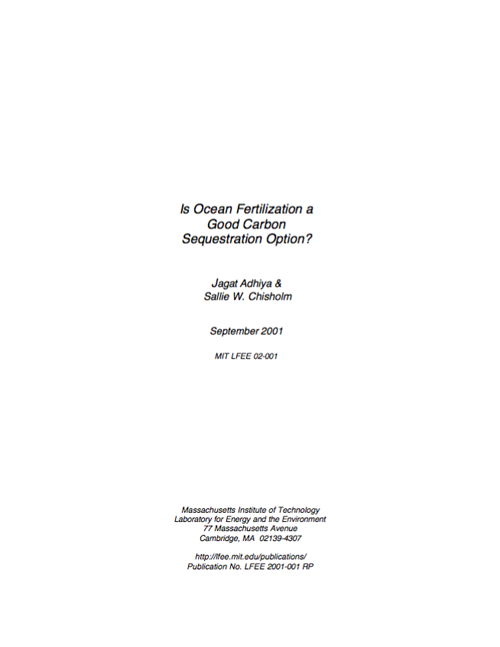
Is Ocean Fertilization a Good Carbon Sequestration Option?
An MIT LFEE Publication
Abstract
Executive Summary
The Policy Issue
The proliferation of fossil fuel-based technologies in the face of a discernible impact of anthropogenic greenhouse gas (GHG) emissions on global climate presents an urgent challenge to develop other mechanisms for mitigation of the greenhouse effect. Much attention has focussed upon ways to curtail the growing stock of atmospheric carbon dioxide (CO2), a major greenhouse gas, by enhancing the natural sinks or processes that remove CO2 from the atmosphere. Among the various approaches proposed, a set of controversial and increasingly prominent ideas involve efforts to short circuit or enhance the natural transfer of atmospheric carbon dioxide into the deep ocean. One such approach involves the addition of otherwise scarce (limiting) nutrients to surface ocean waters to manipulate marine biological production, thus potentially changing the flux of carbon dioxide between the atmosphere and ocean.
It has been hypothesized that releasing limiting nutrients into the euphotic (i.e., sunlit) surface layer of the ocean on a large-scale could stimulate the growth of marine phytoplankton, thus increasing the biologically-mediated uptake of atmospheric CO2 by the ocean and mitigating the greenhouse effect. Results from four open ocean experiments have shown that dissolved iron limitsprimaryproductionincertainnutrientrichregionsoftheocean. Resultsofthesescientific experiments, which were designed without specific applications in mind, have catalyzed a variety of commercial interests in manipulating the biological carbon pump by varying the availabilityofnutrients. Whilecontinuingscientificresearcheffortaddressesthemany ecological uncertainties associated with nutrient manipulation in the marine environment, entrepreneurs have been busy marketing different methods for large-scale ocean fertilization (hereafter simply fertilization) to remove carbon dioxide from the atmosphere. Seven US patents for fertilization methods have been issued during the past seven years and an application for an eighth was filed in January 2001. Meanwhile, corporations and governments have shown a growing interest in early action in order to hedge their bets with respect to the adoption of some kind of GHG trading system in the future. Patented fertilization methods are actively being marketed to such corporations and governments, and coastal nations have also been propositioned to serve as hosts for the generation of potentially valuable carbon credits by ocean fertilization in the prospective hosts territorial waters. Despite these remarkable developments, the necessary dialogue on scientific evaluation criteria for large-scale ocean fertilization is seriously lacking. As a result, most corporations, governments and other stakeholders are ill equipped to properly assess the risks, benefits and true costs associated with proposals for fertilization.
Recommendations
Large-scale field experiments to test specifically for carbon sequestration by fertilization are not warranted at present. We feel that concerns regarding the technical efficacy and ecological impacts of fertilization should be resolved first by a more thorough synthesis of disciplinary knowledge in the aquatic sciences, including input from ecologists and limnologists. Then, if the arguments are still not compelling enough to support sound policy making limited, scientific testing of carbon sequestration methods may be justified.
Policy makers should recognize that carbon sequestration in the ocean is nothing more than a partial, stopgap measure to combat the accumulation of atmospheric CO2. Partial, because the amounts of CO2 captured by fertilization (or other approaches), if the approach were successful, would not substantially mitigate the potential for global climate change. Stopgap, because any CO2 that is trapped in the deep ocean will eventually re-surface, though the timing will depend upon ocean circulation and the duration of the fertilization program. Even if the quick-fixes for atmospheric GHG reduction such as ocean fertilization emerge as technically and economically viable options, there is a need for renewed political commitments to promote the adoption of cleaner energy systems, many of which have been studied intensively for over a generation now. Carbon sequestration may buy human societies a little more time to make the desirable technological and cultural transition to a sustainable system of development, but sequestration is not a sustainable solution to the global warming problem.